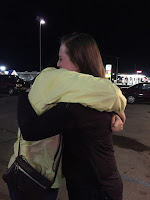semana santa in sevilla
When I was in
Sevilla last time, I remember learning about how amazing Holy Week and La Feria
are in the spring in Sevilla. At the
time, I couldn’t really understand just how
amazing. When I found out that I would
be student teaching in Spain during the spring semester, I knew I would have
holy week off, and I knew I had to
use some of that time to go back to Sevilla.
I actually ended up with 2 weeks, back to back, for spring break and
Holy Week- even better than originally expected.
Semana Santa in
the south of Spain (Andalusia) is much more renowned than Semana Santa anywhere
else in the world, but Seville is a destination. I read lots of blog posts and articles about
how to best see processions and experience the week, and they all mentioned how
Semana Santa in Sevilla is the best in the world and nowhere else can truly
compare to it.
Official Holy
Week processions began on Friday before Palm Sunday. None of these processions were major, so I
didn’t arrange to see any of them.
However, the Palm Sunday or Domingo de Ramos processions were a huge
deal. Around 10 processions left from
various churches all over Sevilla, starting around 1 pm and ending around 2
am!
 |
| The Semana Santa program- this page is just for Domingo de Ramos or Palm Sunday. |
 |
| "La armargura" or the grief/suffering |
Following the
initial round of people walking in their outfits comes the “float” of the
parade. They are called
palios and are made of gold, real candles, and other expensive, hand-crafted
materials. They weigh tons, and men have
the honor of carrying the floats throughout the whole procession. It truly is an honor, and I’ve read that men
will cry and cry if their float can’t leave the church because of rain. There are also guards and men who walk
outside the float to help direct the men carrying it. As I was watching one of the processions, the
director yelled at the men under the float like a motivational speaker or
something. He shouted something to them
about the sacrifice they were making and how important their work is, and that
Spain “has always been, and will always be, Catholic.” The float makes frequent
stops along the way (some of the processions take over an hour to pass by a
certain location, and they have 10-20 locations that they cross. The walkers for each theme move really slowly,
and the live music accompanies the theme and is unique to it.
 |
| The palio of "La argmagura" |
 |
| The palio of "La Estrella" |
A marching band follows the float. After the main float come the people who are
carrying crosses, also dressed in the cloaks.
Finally comes another band and another float that carries the virgin/saint
to end the particular procession.
 |
| Las cruzes or the crosses |
 |
| The end of the procession "La Paz" |
I watched La Paz, La Estrella, and La Armargura
on Domingo de Ramos. Each was unique,
and even though I don’t know a lot about the significance and history, I could
pick up on the different emotions and stories that the processions hoped to
convey. La Paz was the most beautiful, I
thought, because the procession marches through Parque Maria Luis and past the
Plaza de España. I watched La Estrella
pass from right beside the Cathedral in a significant Sevilla location (I also
felt extremely claustrophobic here). I
hadn’t planned to seek out La Armagura, but I happened to cross it as I was
walking back towards my hotel! It was
somewhat of a bonus, and I sat under the Metropol Parisol to watch it pass. I had
planned to watch El Amor, the final and main procession of Palm Sunday, but it
didn’t go out because of the probability of rain- it never ended up raining,
but imagine the chaos if the floats and processions were out and it did storm!
 |
| "La Paz" in Parque Maria Luisa, passing right in front of Plaza de España |
Seeking out all
of the locations and matching up timing to get to see the processions is like a
scavenger hunt through Sevilla. I don’t
know how you could do it well if you didn’t know the city, unless you paid for
tickets to watch in the private areas near the Cathedral. I was out until about 1 am (not late at all
by Sevillana standards), and there was never a moment when I felt unsafe or
nervous. It was such a fun adventure and
energy to see everyone anticipating the processions- even the Sevillanas who
have seen them pass for years and years in exactly the same way. I would love to go back to Sevilla some day
to see more of the Holy Week events, but I’m so glad that I had the chance to
see what I did.
I posted some of
my videos on my YouTube if you want to see more!



Comments
Post a Comment